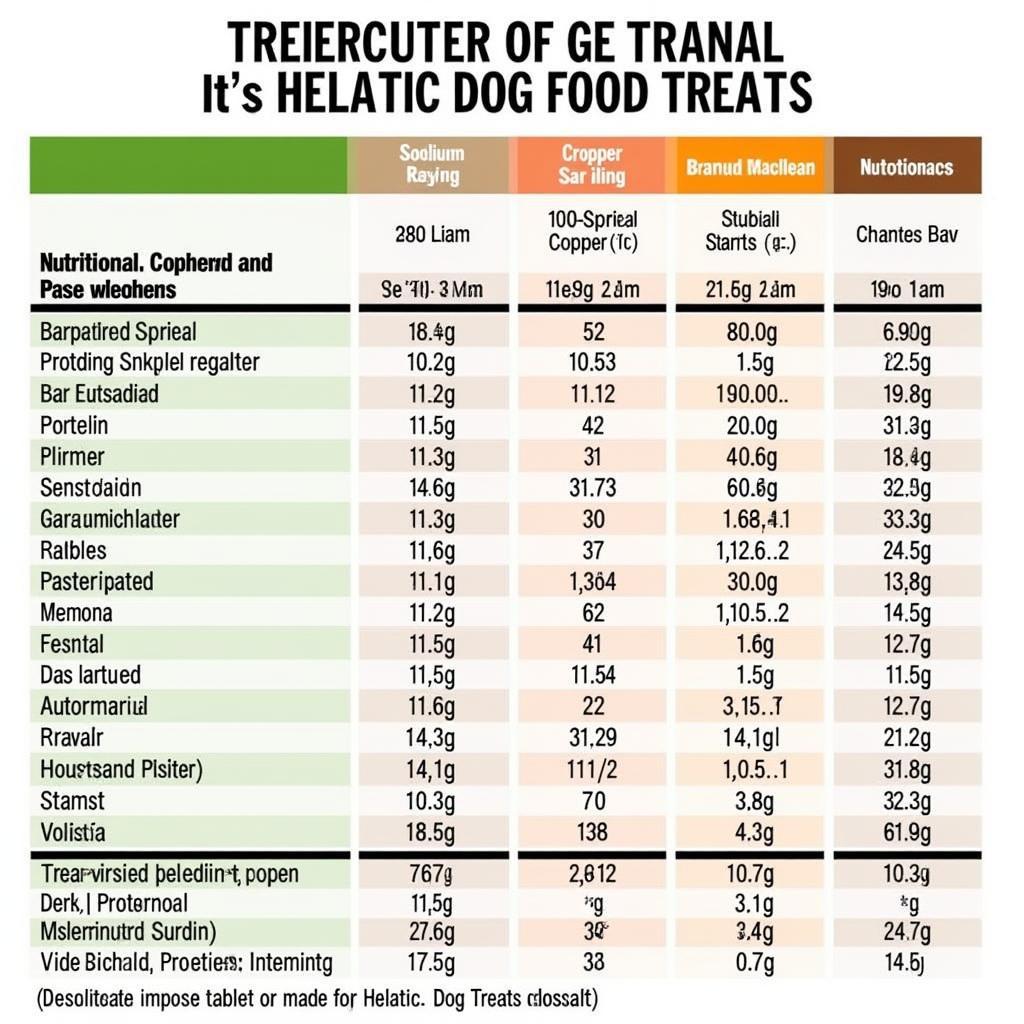Hepatic Dog Food Treats are a crucial part of managing liver disease in dogs. These specialized treats are formulated to support liver function and minimize the strain on this vital organ. Choosing the right hepatic treats can significantly improve your dog’s quality of life. This guide dives into everything you need to know about hepatic dog food treats, from understanding liver disease to selecting the best treats for your furry friend.
Understanding Liver Disease in Dogs
Liver disease in dogs can manifest in various ways, including lethargy, jaundice, vomiting, and weight loss. It’s a serious condition that requires careful management, often involving a prescribed diet and specific medications. A crucial component of this management is incorporating hepatic dog food treats. These treats are not just tasty snacks; they’re specifically designed to support liver health.
Why are Hepatic Treats Important?
Hepatic treats are formulated with reduced protein, copper, and sodium, key factors in managing liver disease. They often include ingredients that support liver function and regeneration. By providing these specialized treats, you’re actively contributing to your dog’s overall well-being and helping to alleviate the symptoms associated with liver disease.
Choosing the Best Hepatic Dog Food Treats
Selecting the appropriate hepatic dog food treats requires careful consideration of your dog’s specific needs and preferences. Always consult your veterinarian before introducing new treats to your dog’s diet, as they can provide tailored recommendations based on your dog’s individual condition.
Key Factors to Consider:
- Ingredients: Look for treats with high-quality, easily digestible ingredients. Avoid artificial colors, flavors, and preservatives.
- Protein Source: Opt for treats with moderate levels of high-quality protein, ideally from sources like chicken or fish.
- Copper Content: Copper restriction is crucial for dogs with liver disease. Ensure the treats are specifically formulated for low copper content.
- Sodium Levels: Low sodium is essential to manage fluid retention, a common issue in dogs with liver problems.
- Added Benefits: Some treats contain added ingredients like milk thistle or SAMe, known for their liver-supporting properties.
 Comparing Hepatic Dog Treat Labels
Comparing Hepatic Dog Treat Labels
How to Incorporate Hepatic Treats into Your Dog’s Diet
Introducing hepatic treats should be done gradually to avoid upsetting your dog’s stomach. Start by offering small amounts and monitor for any adverse reactions. These treats should complement, not replace, your dog’s prescribed hepatic diet.
Tips for Successful Integration:
- Consult your vet: Always discuss dietary changes with your veterinarian before making any adjustments.
- Gradual introduction: Start with small quantities and gradually increase the amount over several days.
- Monitor for reactions: Observe your dog for any signs of digestive upset, such as vomiting or diarrhea.
- Treat as a supplement: Hepatic treats should be used in conjunction with a prescribed hepatic diet, not as a replacement.
- Positive reinforcement: Use the treats as positive reinforcement during training or as a special reward.
“When choosing hepatic treats, prioritize quality ingredients and always follow your veterinarian’s recommendations,” advises Dr. Emily Carter, DVM, a board-certified veterinary internist specializing in small animal internal medicine. “These treats can significantly contribute to a dog’s overall well-being when managing liver disease.”
 Dog Enjoying Hepatic Treat
Dog Enjoying Hepatic Treat
Conclusion
Hepatic dog food treats play a vital role in managing liver disease in dogs. By providing your dog with these specially formulated treats, you’re actively supporting their liver health and overall well-being. Remember to consult with your veterinarian before making any dietary changes and choose hepatic dog food treats that meet your dog’s specific needs. This will ensure your furry friend receives the best possible care and enjoys a happy, healthy life despite their condition.
FAQ
- Can I give my dog regular treats if they have liver disease? No, regular treats are not formulated for dogs with liver disease and can exacerbate the condition.
- Are all hepatic treats the same? No, they vary in ingredients, nutritional content, and added benefits. Consult your vet for the best option for your dog.
- How many hepatic treats can I give my dog per day? Follow your veterinarian’s recommendations, as the appropriate amount varies based on your dog’s size, condition, and overall diet.
- What are the signs of liver disease in dogs? Lethargy, jaundice, vomiting, weight loss, increased thirst, and changes in appetite can be indicators of liver disease.
- Can hepatic treats cure liver disease? No, they are a management tool to support liver function, not a cure.
- What other dietary changes are necessary for dogs with liver disease? A prescribed hepatic diet is crucial, often involving reduced protein, copper, and sodium.
- Where can I buy hepatic dog food treats? Consult your veterinarian or check reputable pet supply stores.
“Monitoring your dog’s response to hepatic treats is crucial,” adds Dr. Carter. “Observe for any changes in their behavior, appetite, or digestion, and communicate any concerns to your veterinarian.”
For further assistance, please contact us at Phone Number: 02437655121, Email: [email protected] Or visit us at: 3PGH+8R9, ĐT70A, thôn Trung, Bắc Từ Liêm, Hà Nội, Việt Nam. We have a 24/7 customer support team.